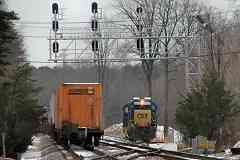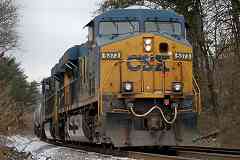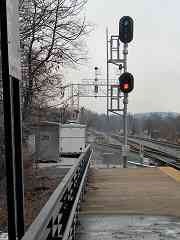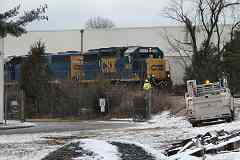|
 As seen from Dorsey Station, this is the same Dorsey interlocking, but
looking the opposite direction at a time when the color-position light
signals (CPLs) were still on duty.
As seen from Dorsey Station, this is the same Dorsey interlocking, but
looking the opposite direction at a time when the color-position light
signals (CPLs) were still on duty.
With CPLs, even if you could not discern the color, the angle of the
imaginary line connecting the illuminated pair conveyed the basic
instruction (go in the main photo, and stop in the photo at right).
Details were supplied by the lamps above and below the central disk.
Most signal diplays tell the operator two things: the speed at which
to operate here, and the speed ahead. Since many trains are heavy and
require a long time to stop, the "speed ahead" information lets the
operator know how to prepare for the next signal, one that might
express a slower speed, or even to stop.
With large LED displays becoming common, if I were redesigning the
system I would show the speed here and the speed ahead as simple numeric
values, perhaps with various colors. For example, 20-0 would tell the
operator speed 20 here, be prepared to stop (speed 0) at the next signal.
Special situations could be represented by letters. For example, 10-X
would mean speed 10 here, entering unsignalled territory next. Full stop
would be shown as a red 0-0 which, coincidentally, would resemble the two
red lamps of a B&O CPL signal. Other special instructions could be
represented by blinking, underlines, a box around the digits, or
similar.
|
























